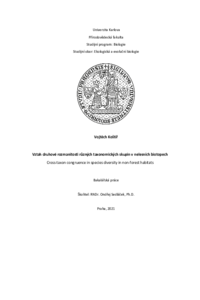Vztah druhové rozmanitosti různých taxonomických skupin v nelesních biotopech
Cross-taxon congruence in species diversity in non-forest habitats
bakalářská práce (OBHÁJENO)

Zobrazit/
Trvalý odkaz
http://hdl.handle.net/20.500.11956/126258Identifikátory
SIS: 221252
Kolekce
- Kvalifikační práce [20084]
Autor
Vedoucí práce
Oponent práce
Tropek, Robert
Fakulta / součást
Přírodovědecká fakulta
Obor
Ekologická a evoluční biologie
Katedra / ústav / klinika
Katedra ekologie
Datum obhajoby
1. 6. 2021
Nakladatel
Univerzita Karlova, Přírodovědecká fakultaJazyk
Čeština
Známka
Dobře
Klíčová slova (česky)
biodiverzita, klíčové druhy, deštníkové druhy, zástupné druhy, nelesní biotopy, managementKlíčová slova (anglicky)
biodiversity, keystone species, umbrella species, flagship species, surrogate species, non-forest biotops, managementVztahy mezi různými taxonomickými skupinami jsou jedním z hlavních faktorů ovlivňujícím ekosystémy na Zemi. Tato práce shrnuje korelace druhového složení a korelace druhové bohatosti na různých prostorových škálách. Znalost těchto tzv. cross-taxon congruences je zásadní pro ochranu přírody a managment druhově bohatých lokalit nelesních biotopů. Jedním z hlavních cílů této práce bylo najít zástupné taxony vhodné pro ochranu biodiverzity na nelesních biotopech. Bezobratlí a cévnaté rostliny jsou obecně dobré zástupné taxony pro ochranu biodiverzity. Například, střevlíci mají dobré korelace druhové bohatosti na širokých prostorových škálách. Na jemných prostorových škálách však jejich důležitost výrazně klesá. Na obou typech škál druhová bohatost mravenců a motýlů pozitivně koreluje s druhovou bohatostí. Obratlovci se naproti tomu ukázali jako nevhodný zástupný taxon, vyjma ptáků, které je možné vložit do "shopping basket" s bezobratlými a cévnatými rostlinami. Na jemných škálách se druhové složení mění s typem hospodaření na studovaných lokalitách. Z těchto specifických druhových společenstev můžeme vybrat vhodné deštníkové druhy. Nejlepší deštníkové druhy nelesních biotopů jsou bezobratlí herbivoři jako motýli a rovnokřídlí, mezi kterými najdeme habitatové specialisty. Definování těchto zástupných a...
Relationships between different groups of organisms are one of the major factors shaping Earth's ecosystems. This thesis analyses correlations in species composition and species richness at different spatial scales. Knowledge of these so-called cross-taxon congruences are crucial for proper nature conservation and management of species-rich localities of non-forest habitats. One of the main aims of the thesis was to find suitable surrogate groups for biodiversity conservation in non-forest habitats. Invertebrates and vascular plants are generally good surrogate groups for biodiversity conservation. For example, ground beetles seem to have good correlations in species richness at large spatial scales. However, their importance deeply declines at small spatial scales. At both scales, the species richness of ants and butterflies positively correlates with general species richness. Vertebrates, on the other hand, appear to be a bad surrogate taxon, except for birds which can be placed into a shopping basket with invertebrates and plants. At small scales, species composition differs with the type of agricultural use at studied localities. Umbrella species can be selected from these specific species communities. Best umbrella species for non-forest habitats are invertebrate herbivores such as butterflies...
